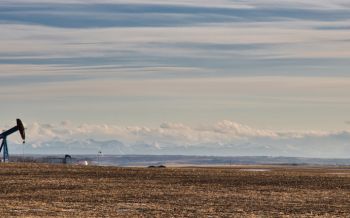Loss-making Canadian oil sands players Cenovus Energy and Husky Energy are merging to create a new integrated oil and gas company after agreeing an all-stock transaction valued at CAD 23.6 billion (USD 18 billion). The combination will create the second largest Canadian-based refiner and upgrader and the third largest Canadian producer with about 750,000 boe/d of production. The deal will result in CAD 1.2 billion of annual savings and unquantified job losses that directors hope will mitigate the worst effects of deteriorating oil prices.
The post-merger company will have “long-life” 2P reserves of ~9.0 billion boe with a reserves life index (RLI) of 33 years. It will have combined takeaway capacity from Alberta of 265,000 barrels/d from existing pipelines and another 305,000 barrels/d from planned additions, plus 660,000 boe/d of upgrading and refining capacity.
Cenovus shareholders will own approximately 61% of the combined company, with Husky shareholders owning the rest. It will trade under the name of Cenovus Energy and remain headquartered in Calgary, Alberta.
Husky shareholders will receive 0.7845 Cenovus shares plus 0.0651 of a Cenovus share purchase warrant in exchange for each Husky common share. This represents a 21% premium, or 23% including warrants, relative to Husky’s five-day average price on 23 October. Shares in Cenovus crashed 13.5% on news of the merger, while Husky stock spiked by the same proportion, suggesting traders see the combination as heavily one-sided.
The deal represents a lifeline to Hong Kong business magnate Li Ka-shing’s CK Hutchison conglomerate, which owns 40.19% of Husky’s common stock. The aggregate consideration package for Husky shareholders implies a transaction equity value for Husky of approximately CAD 3.8 billion, and a transaction enterprise value for Husky of some CAD 10.2 billion. By comparison, the market capitalisation of Husky was only CAD 3.19 billion prior to the merger announcement.
Li’s Canadian oil sands bet had already turned sour long before Covid-19 pummelled the market. In the 11 years since its peak in 2008, Husky’s share price had already collapsed more than 80%. That period was punctuated by a dividend suspension, production cut and failed hostile takeover of compatriot oil sands rival MEG Energy.
Husky’s losing streak accelerated with the pandemic-induced oil price crash and ensuing lower price environment. Husky has lost 70% of its share value since the New Year, and 34% over the last three months. Husky reported a net loss of CAD 2.34 billion for the three months ended 31 December 2019 and consecutive losses for the subsequent two quarters.
Cenovus has fared little better, with shares trading down 63% since 1 January and 27% since late July. It scraped to a narrow net profit in the final quarter of 2019 but crashed to consecutive net losses of CAD 1.8 billion in Q1’20 and CAD 235 million in Q2’20.
Before the crash, Cenovus hiked its dividend by 25% in October 2019 and declared it was positioned for CAD 11 billion of cumulative free funds flow (FFF, similar to free cashflow) through 2024 if West Texas Intermediate (WTI) averages USD 57-60/barrel – prices that look wildly optimistic by today’s standards.
Vanishing margins
The merger with Cenovus was conceived as a zero-premium “at-market” merger, but the plummeting value of Canadian oil sands producers during the merger due diligence period over the past months means the agreed share exchange ratio now represents a fairly handsome premium to the prevailing Husky stock price.
With WTI falling back below USD 40/barrel, the boards of both companies unanimously agreed to the merger in the hope of reversing their failing fortunes. But the transaction presentation reveals that the merged entity will produce only a sliver of FFF at USD 40 WTI, and presumably even less at today’s price.
The pair anticipate their free cashflow breakeven price will reduce from USD 36/barrel WTI in 2021 to less than USD 33/barrel WTI in 2023, which is “lower than either company on a standalone basis”. Key to achieving this will be “workforce optimization”, Cenovus’s “low capital cost structure” in its Foster Creek Christina Lake (FCCL) oil sands assets, and Husky’s “steady cash flows from high netback production in Asia Pacific”.
The gas-rich Asia-Pacific assets produce around 50,000 boe/d, accounting for around 7% of the combined entity’s proforma 750,000 boe/d 2020 production. The assets offshore China and Indonesia generate approximately USD 1 billion in annual free funds flow through sales largely under long-term contracts, and Cenovus drew attention to this in its announcement of the merger.
“We will be a leaner, stronger and more integrated company, exceptionally well-suited to weather the current environment and be a strong Canadian energy leader in the years ahead,” said Cenovus CEO Alex Pourbaix. “The diverse portfolio will enable us to deliver stable cash flow through price cycles, while focusing capital on the highest-return assets and opportunities.”
The combined business will have net debt of USD 12 billion upon closing including Husky’s net debt of USD 5.1 billion, with net debt to EBITDA ratio of 3x. The pair hope to reduce net debt to USD around USD 8 billion and 2x EBITDA by 2023. The combined entity will have USD 8.5 billion in undrawn committed credit facilities from a broad banking syndicate, and will face its first USD 1 billion of debt maturities in 2022.
Both companies claim to be committed to environmental, social and governance (ESG) issues, and highlighted their joint “ambition” to achieve ‘net zero’ emissions by 2050. Further details will be released post-merger.
“Striking the right balance among environmental, economic and social considerations is central to our strategy of creating long-term value and business resilience for our company,” said Pourbaix.
The merger is expected to close in Q1’21, pending approval by 66% of Husky shareholders and a majority of Cenovus investors. Husky’s significant shareholders – include CK Hutchinson – representing 70% of Husky voting rights have already committed to support the deal. - SK
Subscription Benefits
Our three titles – LNG Business Review, Gas Matters and Gas Matters Today – tackle the biggest questions on global developments and major industry trends through a mixture of news, profiles and analysis.
LNG Business Review
LNG Business Review seeks to discover new truths about today’s LNG industry. It strives to widen market players’ scope of reference by actively engaging with events, offering new perspectives while challenging existing ones, and never shying away from being a platform for debate.
Gas Matters
Gas Matters digs deep into the stories of today, keeping the challenges of tomorrow in its sights. Weekly features and interviews, informed by unrivalled in-house expertise, offer a fresh perspective on events as well as thoughtful, intelligent analysis that dares to challenge the status quo.
Gas Matters Today
Gas Matters Today cuts through the bluster of online news and views to offer trustworthy, informed perspectives on major events shaping the gas and LNG industries. This daily news service provides unparalleled insight by drawing on the collective knowledge of in-house reporters, specialist contributors and extensive archive to go beyond the headlines, making it essential reading for gas industry professionals.





